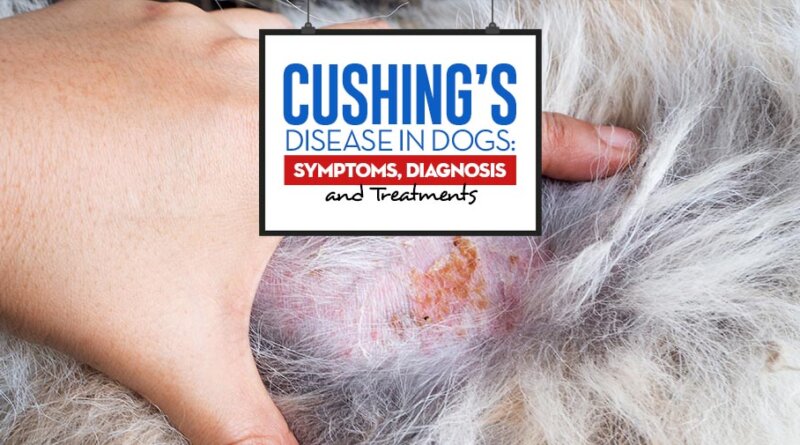Science on Symptoms, Diagnosis, Treatments
If you’re not familiar with the condition, Cushing’s Disease in dogs affects the animal’s endocrine system. This condition is most prevalent in older dogs and is commonly caused by a pituitary gland tumor. You can also see the disease in humans with similar symptoms.
Speaking of the symptoms of Cushing’s Disease in dogs, they can include:
- Excessive or constant panting
- Increased appetite
- Potbelly
- Extreme unquenchable thirst
As far as treatments for Cushing’s Disease in dogs, the first option is usually surgery. If the tumor is benign, your veterinarian will ordinarily be able to remove the growth and return your dog to full health. With older dogs or inoperable cases, holistic and medical treatments are available to manage the symptoms of Cushing’s Disease well.
According to veterinarians, one of the most promising treatments is, in fact, the easiest for you to do – cooking your own homemade dog food for your pet. By switching your dog to homemade diet recipes, plenty of which you can find here, and feeding the dog at frequent intervals, you’ll help him to decrease these difficult symptoms substantially.
That’s a brief overview of Cushing’s Disease in dogs, but there is a lot more that you need to know if you know or suspect that your dog may have the condition. This article will explain more about the disease itself, the breeds that suffer from a genetic predisposition to the condition, and the best diet for a dog diagnosed with Cushing’s Disease.
ASK A VET: Does Hypoallergenic Dog Food Really Work and Why?
Cushing’s Disease in Dogs
symptoms, diagnosis, and best treatments
What is Cushing’s Disease in Dogs?
Before we get into the treatments, pet owners need to understand the basics of what happens to dogs with Cushing’s and what the causes are. Cushing’s Disease, or to use the scientific term – Hyperadrenocorticism – is one of the most common disorders of the endocrine system in canines, according to research (1).
A benign tumor causes the hyperadrenocorticism condition in dogs on the pituitary gland in the dogs and horses (2), the part of the body that is responsible for producing the hormone called adrenocorticotropic.
This hormone then stimulates the adrenal glands in the dog located near his kidneys to release the hormone cortisol. The cortisol hormone is also known as “stress hormone” because it helps the body when experiencing stress to keep the blood sugar levels steady and fend off infections.
The amount of adrenocorticotropic hormone released varies with factors, including whether the dog’s body is experiencing stress from injury or cold temperature. When Cushing’s Disease is present, this system doesn’t work as it should (3).
This disease confuses the body and causes it to shoot too much of the cortisol hormone into the bloodstream. It causes toxicity in the canine’s body, and essentially the dog is being poisoned from the inside by his own body. Other vital systems will be affected as well, including the gastrointestinal system (4).
Who Can Suffer from Cushing’s Disease?
Cushing’s Disease in dogs is most commonly found in middle-aged and older canines (5).
Almost all dogs diagnosed with Cushing’s are over eight years (6), with the median age being ten. As noted above, studies observed that in most cases, the cause of Cushing’s in dogs is most often a benign tumor of the pituitary gland. However, other causes include tumors of the adrenal gland and endocrine system cancer.
Vets have been known to accidentally cause their canine patients to develop this condition when dealing with dogs suffering from a deficient cortisone level.
They conduct replacement therapy by giving cortisone injections. When too much cortisone is given, this may initiate Cushing’s Disease in dogs. And, if you thought that was strange, wait until you hear an even rarer cause – steroid-containing ear drops (7).
Certain dog breeds suffer from a genetic predisposition to Cushing’s Disease. The breeds most commonly observed as predisposed to this include:
- Poodle
- Boxer
- Yorkshire Terrier
- Beagle
- Scottish Terrier
- Dachshund
- German Shepherd
- Labrador
- Boston Terrier
RELATED: 3 Common Canine Diseases Linked To Dog Food
Common Symptoms of Hyperadrenocorticism in Dogs
Unfortunately, this condition can be difficult for the owner to detect as there aren’t obvious symptoms such as your dog fainting and coughing.
Instead, the symptoms of Cushing’s Disease in dogs can seem like normal issues that come along as your dog gets older. Some research suggests that canines that have been spayed or neutered are more at risk of developing this condition.
Studies have observed (8) these as the most common symptoms of Cushing’s Disease:
- Muscle Weakness
- Shortness of breath during exercise
- Increased appetite
- Potbelly
- Extreme unquenchable thirst
- Hair loss
- Redistribution of fat storage to the belly
- Skin infections and thinning
All the above symptoms are very similar to those experienced by humans with Cushing’s Disease. In fact, some studies found (9) the condition to be almost identical between humans and dogs in how symptoms present themselves and how they are dealt with.
Diagnosing Cushing’s Disease in dogs
To diagnose Cushing’s Disease in dogs, your veterinarian will need to perform a full physical exam. They’ll also have to find out the history of the canine to see whether the symptoms correlate with normal aging or whether something has gone awry.
First, your veterinarian will test your pet’s urine for elevated levels of cortisol. If elevated levels are indicated, they can then perform what’s called the adrenocorticotropin hormone (ACTH) stimulation test that will determine whether or not this excess in cortisol levels in your dog’s body is due to Cushing’s Disease or something else.
However, this isn’t the only test that your dog is likely to go through since there are many other diseases with similar symptoms (10), therefore likely further examination will be required at your vet clinic.
Is Cushing’s Disease contagious?
No, it’s not.
Cushing’s Disease in dogs is a condition caused by an imbalance of hormones, often due to a tumor on the pituitary gland. Therefore, you can be certain that this condition cannot be contagious, and your other dogs or yourself will not contract it.
READ: 18 Tips on How to Save Money on Dog Care, Health, Vet Bills, and Meds
Treatment for Cushing’s Disease in dogs
As noted above, Cushing’s Disease is often caused by a tumor on the pituitary gland. Where the tumor is benign, and surgery is an option, the recovery prognosis from the disease is very high, according to research (11).
In some inoperable cases, or when the owner chooses not to go for the surgery, radiation can sometimes shrink the tumor. When the tumor shrinks, it will alleviate the intensity of the symptoms.
Your veterinarian will develop the best plan of action on dealing with and treating Cushing’s disease in the dog, including several medical treatments. For example, a study of 42 dogs (12) with Cushing’s Disease showed promising results when the dogs were orally given ketoconazole or retinoic acid. Other treatments will be discussed, too.
Switching to homemade dog food
Dietary changes are one of the key treatments (13). Dogs with Cushing’s have shown remarkable improvement in their overall quality of life when switched from their normal processed diet to a homemade diet consisting of fresh vegetables and meat. It’s also beneficial to serve smaller meals every few hours instead of one large meal.
It’s important to avoid any “fad” diets, such as Meat-Only Raw Food Diet, and consider the specific nutrient requirements the dog needs. Remember that only 11,000 years ago, our current day dog began to develop. While starting as the noble wolf, they survived on hunted prey alone; today’s dog has a much more complex digestive system (14) – able to break down a more varied diet, including foods such as rice and potatoes.
There are advocates of Raw Diets/BARF/etc. that still argue that dogs should eat a diet dating back to their wolf ancestors, mostly raw meat. However, studies confirm (15) that dogs are capable and healthier when eating a more varied diet.
Owners of dogs with Cushing’s Disease are often given a homemade meal plan from their veterinarian and encouraged to try the new diet for a period of one month to two months before discounting it.
Some of the benefits that come along with feeding your dog homemade food include:
1. Knowing exactly what’s in your dog’s food – With homemade dog food, you know precisely what your dog is getting—fresh, wholesome, human-grade ingredients with no additives, preservatives, and no superfluous bulking agents. Processing food typically removes or destroys nutrients and fiber present in the whole foods that remain healthy.
2. Allergy safe – Human and canine co-evolution doesn’t stop at our bellies. An unfortunate predisposition that we share is allergies. Just as we suffer from the corresponding sniffles, rashes, and tummy aches, our canine companions also can. Your veterinarian can test your dog for allergies and help you find a diet plan that will meet his unique dietary requirements.
3. Lean body equals longer life – Sadly, our companion animals have also evolved to be susceptible to the same diseases that we battle with. Struggles with obesity run rampant. This is due in part to readily available processed food. Several diseases exist that are known to be exasperated by weight gain, including Cushing’s Disease in dogs, diabetes, heart disease, and cancer. In short, the healthiest way to live is lean.
4. Save money – Cooking with human-grade ingredients for your dog doesn’t have to cost a lot. Cooking from scratch once per week (or even once per month) and freezing portions can cost less than sacks of dog food for the same period.
Read more about the benefits and side effects of homemade dog food, and make sure you understand what a well-balanced homemade dog food meal consists of to avoid causing any further complications to your dog’s health. Always discuss this with your veterinarian.
VIDEO GUIDE: How to Make Homemade Dog Food
Sample Cushing’s Dog Food Recipes

Below I’m sharing two popular recipes that are especially good for dogs suffering from Cushing’s.
Beef, Sweet Potato, and Pea Dog Food
- 3 lbs (raw weight), beef, cooked
- 3 lbs sweet potato, cooked
- 2 1/3 lbs peas, cooked
- 7 teaspoons sunflower oil
Once cooked, mix all the ingredients in a large mixing bowl. The serving size will depend on your dog’s overall health condition and should be discussed with your veterinarian.
Eggs, Macaroni, and Broccoli Dog Food
- 3 eggs, hard-boiled
- 1 cup macaroni, cooked
- 1 cup broccoli, cooked
Once cooked, mix all the ingredients in a large mixing bowl. The serving size will depend on your dog’s overall health condition and should be discussed with your veterinarian.
Home remedies for Cushing’s Disease in Dogs
While you must discuss any possible medical treatment for Cushing’s Disease with your vet, many owners and veterinarians swear by natural treatments to increase the quality of life for their affected canines. It’s important to note that these aren’t out and out cures for Cushing’s Disease in dogs, but rather ways to manage the symptoms.
Also, remember that because these treatments are along the lines of the holistic veterinary area, there is no scientific evidence whether they will definitely work for your dog or not.
 1. Cushex
1. Cushex
According to the manufacturer and praise from other dog owners’ reviews, this herbal remedy has been created purely for Cushing’s Disease in dogs in mind. It features some natural ingredients with a proven ability to boost adrenal and pituitary function. This supplement is suitable for dogs of all sizes, breeds, and ages.
2. Adrenal Harmony Gold

Throughout my research, I saw plenty of anecdotal evidence in the form of numerous positive reviews of this product. Owners praise the difference that this remedy has made in their dog’s happiness.
3. Make Your Own
For those with a little more time on their hands, it’s possible to make your own natural homemade remedies for Cushing’s Disease in dogs by combining some of the herbs that have been observed to assist in decreasing or altogether stopping certain symptoms. Again, remember that there is no scientific basis for the effectiveness of the below.
Here are some of the herbs that are claimed to help dogs with Cushing’s Disease:
- Dandelion – Besides being a restorative for the liver and kidneys, Dandelion helps boost adrenal function and gives a good boost of vitamins and minerals to help with energy levels and vitality.
- Burdock – This lesser-known yet almost miracle herb is great for flushing toxins from the body and maintaining blood sugar levels.
- Sulfur – Especially helpful in reducing the excessive thirst that comes along with this condition.
- Astragalus – Another adrenal function booster, this herb also gives the immune system a much-needed boost.
- Si Miao San – This Chinese remedy tends to work best for obese dogs that suffer from excessive panting due to their Cushing’s. This herbal formula regulates insulin and improves digestion – but, most importantly, it decreases inflammation.
- Ginkgo Biloba – Ginkgo works in almost the same way as Si Miao San. However, some dogs take to one rather than the other. The best way to determine this is to consult your local Holistic Veterinarian.
- Mercurius – Another thirst quencher, it also works as a stress reliever for dogs who are becoming upset from the sudden onset of symptoms.
RELATED: 15 Cheap Ways To Prevent Most Common Health Issues In Dogs
Veterinary Treatment for Cushing’s Disease in Dogs
As well as surgery being an option in some cases, I’ve already mentioned that multiple medications can help with Cushing’s Disease in dogs and the associated symptoms, some of which have been proven in studies to be quite effective.
The ultimate prescription will come down to your dog’s specific needs. The intensity of symptoms can vary greatly in Cushing’s Disease that which’s one of the few conditions that require entirely different treatment depending on the severity, symptoms, and lifestyle.
As this medical ailment mainly affects older dogs, many owners choose to forego medical treatment. Instead, they choose to let their dogs live out their lives to the fullest.
Many owners who opt out of medical treatment will go above and beyond, taking up an immediate switch to 100% homemade dog food meals for their four-legged friends. They usually try herbal remedies to help deal with symptoms as well.
At the Tail’s End…

Many assume that when a dog is diagnosed with Cushing’s Disease, that it’s akin to a death sentence, but that’s not the case at all. This condition is so common in dogs (and horses) that the chances are you may know a dog suffering and not even realize it.
READ NEXT: 25 Most Serious Dog Health Symptoms That Cannot Be Ignored
References









